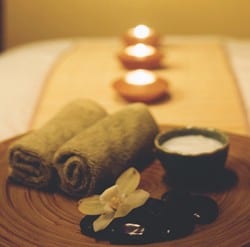 Spas are embracing social media and shifting their focus to appeal to the Millennial generation, according to the International SPA Association. The group released its list of 10 trends to look for in spas next year, which include a focus on reducing stress, simplifying spa menus, and incorporating social networking and cell phone applications.
Spas are embracing social media and shifting their focus to appeal to the Millennial generation, according to the International SPA Association. The group released its list of 10 trends to look for in spas next year, which include a focus on reducing stress, simplifying spa menus, and incorporating social networking and cell phone applications.
Several of the trends noted by ISPA, including "Preventive Care" and "Beauty Rest" (incorporating naps into treatments), focus on the therapeutic value of spas for managing stress. Since the recession began, luxury has taken a back seat to health and stress relief in spas, according to ISPA President Lynne McNees. "We’re dealing with more stress at more levels today, but you can spend a lot of money and a lot of time in a doctor’s office curing diseases, or you can spend a little time and money now and manage it," she says. "It’s not going to go away, it’s only going to get worse."
She connected this to another trend, "the Millennials Take Over." McNees sees the younger generation as more dedicated to preventive health efforts and more comfortable and familiar with spa offerings than their parents or older generations. They are also more at ease with technology, which explains why social media and cell phone applications made the list.
McNees says Twitter and Facebook allow spas to strengthen loyalty or connect with clients with more immediacy. If a spot opens up, a spa can send out a Twitter message and have interested clients fill the space right away. She cites a study by Ad-Ology that found that 57 percent of 18 to 24 year olds and 48.5 percent of 25 to 34 year olds say social media influenced their choice of a hair salon/barber or day spa. Mobile apps like FindaSpa or brand apps like one offered by Four Seasons, also helps engage younger consumers.
But even as spas begin to embrace technology, maintaining spas as a refuge from the busyness of the outside world remains key, according to McNees. "We’re on overload—it’s 24-hour Facebook, Twitter, Blackberry—all those things are helping us certainly, but we’ve got to protect and carve out those places that allow us to just be."
Here is the complete list of the International SPA Association’s spa trends for 2010:
1. Social Media – Perhaps you’ve heard of a little website called Twitter? It’s helped to bust open the doors on a marketing revolution, and spas are leading the way. Now, it’s easier than ever for spas to offer up-to-the-minute deals by tweeting or posting a Facebook message. Cancellations are no longer a problem when you can re-book an appointment instantly.
2. Customer Service – Consumers are more aware of every penny spent, and with that comes higher expectations on the level of service they receive. Spas are responding by providing exceptional service and making each visit a customized experience for the guest. In fact, 87 percent of ISPA member spas are utilizing customer feedback mechanisms to ensure they’re exceeding consumers’ needs. And 48 percent of ISPA member spas have implemented customer loyalty programs, allowing them to offer discounts or rewards while incentivizing frequent visits to the spa.
3. Spa Sampling Menu – Just like ordering tapas at a Spanish restaurant, now you can order up a sampling of spa treatments to try out. These mini services at lower price points are popular ways to get a taste of treatments offered at many spas. With 46 percent of ISPA member spas seeing an increase in shorter (30 minutes or less) treatment bookings, and 86 percent offering shorter treatments, it’s the perfect recipe for consumers seeking small treats to help lift their spirits.
4. Preventive Care – Wouldn’t you rather go to a spa now to learn how to manage stress then end up in a doctor’s office a few years down the road? According to the World Health Organization, by 2020 the top five diseases will all have the underlying contributing factor of stress. Spa treatments like massage, acupuncture, and meditation have been proven to aid in stress reduction and recovery time for pre and post-op patients.
5. Spa Partnerships – Spas are becoming more accessible through partnerships with established franchises, hotels, and local businesses. Recent pairings like Murad Inc. and Massage Envy will allow consumers to enjoy the benefits of a total spa experience for an affordable price. Forty-six percent of ISPA day spa members partner with local businesses to incorporate spa into their workplace. Popular partnerships include: developing wellness programs at local hospitals, accommodating guests at local hotels without spa facilities, and service discount trades between spas and local business employees.
6. Cell Phone Applications – There’s definitely an app for that! Spa-ing is easier than ever with the convenience of doing it from your cell phone. The Four Seasons’ app allows you to browse spa services and check room availability for your next stay. The Hot Springs and Spa Finder – California app will guide you to road-side soaks, spiritual retreats, and commercial spas. Plan a spa vacation from anywhere with Tripology’s app. The Find a Spa app detects your location and displays search results for spas in your proximity.
7. Giving Back – Spas are offering promotions and free services to people who serve the community such as teachers, hospice workers, and military personnel. Some spas are teaming up with local hospitals and providing wellness education to help educate consumers on the spa lifestyle. Community outreach is a great way to generate business and show how easy it is to incorporate spa into your life.
8. The Millennials Take Over – This group now outnumbers the baby boomers, and they are flocking to the spa. They grew up in a culture where taking care of themselves, learning proper grooming techniques and leading a healthy lifestyle were not options, but the norm. Born during the exercise craze of the 1980s, they were the first generation to watch as their parents began turning to spas through the 1990s, when spas experienced significant growth. Spas are reaching Millennials through social media outlets and they are reaping the benefits.
9. Simplified Spa Menus – Everyone is cutting back and spa menus are no exception. You’ll notice fewer treatment options because spas are focusing on the core of their business—results-oriented treatments. No-frills treatments that offer a return on investment are what the consumer is demanding. The No. 1 spa treatment that people seek out worldwide is massage because of its healing and stress-reducing benefits. And the No. 1 reason people go to the spa is to relieve/reduce stress and relax.
10. Beauty Rest – Catching some zzz’s has never been harder in our sleep-deprived society. The spa makes rest a priority by offering treatments targeted to get you some shut eye. You can actually book time to sleep at the spa or stay after a treatment to nap when you’re feeling relaxed.
10 Spa Trends for 2010
The rise of social media, Millennials, and stress are spurring change in tomorrow's spas.

10 Spa Trends for 2010
The rise of social media, Millennials, and stress are spurring change in tomorrow's spas.


